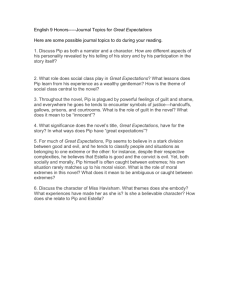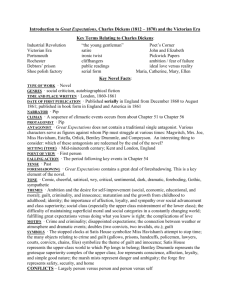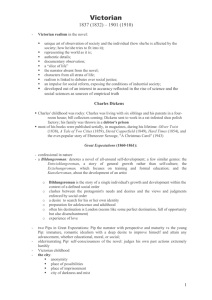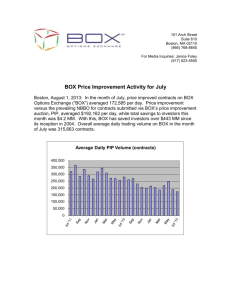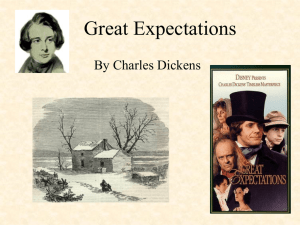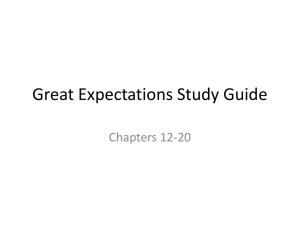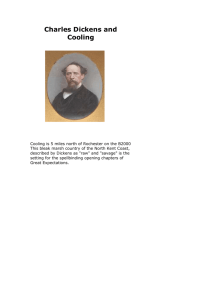SG-Great Expectations.indd - Saddleback Educational Publishing
advertisement
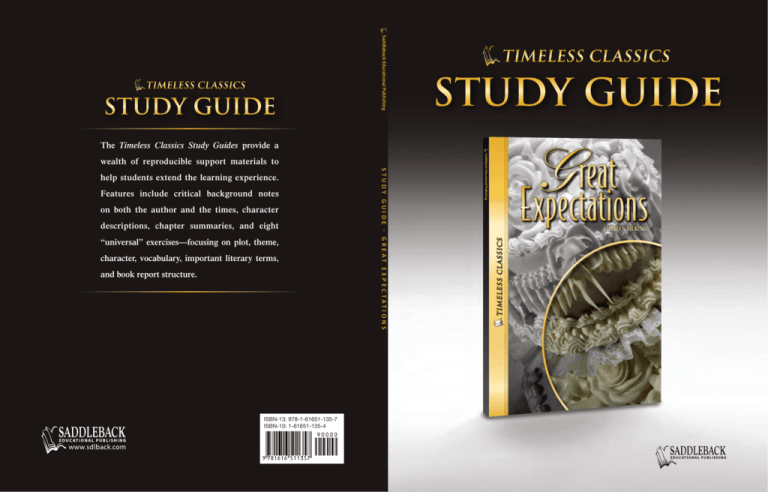
Saddleback Educational Publishing STUDY GUIDE The Timeless Classics Study Guides provide a wealth of reproducible support materials to Features include critical background notes on both the author and the times, character descriptions, chapter summaries, and eight “universal” exercises—focusing on plot, theme, character, vocabulary, important literary terms, and book report structure. ISBN-13: 978-1-61651-135-7 ISBN-10: 1-61651-135-4 S T U D Y G U I D E - g r e a t e x pe c t a ti o n s help students extend the learning experience. STUDY GUIDE | Contents | Notes to the Teacher............................. 4 Facts About the Author........................ 5 Facts About the Characters.................. 6 Facts About the Times.......................... 7 Chapter Summaries.............................. 7 Answer Key........................................ 10 Literary Glossary............................... 12 CHAPTER EXERCISES 1 2 3 4 5 6 7 8 9 10 11 12 13 1 6 1 7 1 8 1 9 2 0 Personalizing the Story, Ch. 8.... 29 2 1 2 2 2 3 2 4 Words and Meanings, Ch. 11.... 34 Words and Meanings, Ch. 9...... 30 Comprehension Check, Ch. 9. .. 31 Words and Meanings, Ch. 10.... 32 Who Did What?, Ch. 10........... 33 Sequence of Events, Ch. 11...... 35 Words and Meanings, Ch. 12.... 36 Inference, Ch. 12. ................... 37 Words and Meanings, Ch. 1...... 14 Character Study, Ch. 1............... 15 END-OF-BOOK EXERCISES Words and Meanings, Ch. 2...... 16 25 Book Sequence.......................... 38 Figurative Language, Ch. 2....... 17 2 6 26 Words and Meanings, Ch. 3...... 18 Final Exam, Part 1..................... 39 Final Exam, Part 2..................... 40 Comprehension Check, Ch. 3.... 19 Words and Meanings, Ch. 4...... 20 UNIVERSAL EXERCISES Sequence of Events, Ch. 4......... 21 27 Beyond the Text......................... 41 Words and Meanings, Ch. 5...... 22 28 Plot Study.................................. 42 Synonyms/Antonyms, Ch. 5...... 23 29 Theme Analysis......................... 43 Words and Meanings, Ch. 6...... 24 30 Character Study......................... 44 Descriptive Words, Ch. 6........... 25 31 Vocabulary Study....................... 45 Words and Meanings, Ch. 7...... 26 32 Glossary Study.......................... 46 14 Cause and Effect, Ch. 7............. 27 33 Book Review, Part 1.................. 47 15 Words and Meanings, Ch. 8...... 28 33 Book Review, Part 2................. 48 TIMELESS Classics NOTES TO THE TEACHER THE NOVELS Timeless Classics were expressly designed to help struggling readers gain access to some of the world’s greatest literature. While retaining the essence and stylistic “flavor” of the original, each novel has been expertly adapted to a reading level that never exceeds grade 4.0. An ideal introduction to later investigations of the original works, Timeless Classics utilize a number of strategies to ensure the involvement of struggling readers: airy, uncomplicated page design; shortened sentences; easy-reading type style; elimination of archaic words and spellings; shortened total book length; and handsome illustrations. o further engage struggling readers, some T of our Timeless Classics titles are available in a new and exciting graphic format, which can bridge literacies and build complex reading skills—a perfect opportunity for differentiation. THE STUDY GUIDES he Timeless Classics Study Guides provide T a wealth of reproducible support materials to help students extend the learning experience. Features include critical background notes on both the author and the times, character descriptions, chapter summaries, and eight “universal” exercises that may be used for any Timeless Classic or Saddleback Illustrated Classic. In addition to the universal exercises, 26 title-specific activities are included to review, test, or enrich the student’s grasp of important vocabulary and concepts. These reproducible worksheets are designed to be used chapter-bychapter as the student’s reading of the novel proceeds. At least two exercises are provided for each book chapter. One of the two always focuses on key vocabulary. The other may be a simple comprehension check or present an important literary concept. 4 Research shows that the most effective way to improve comprehension is to teach students strategies. The foundation of any comprehension strategy requires knowledge of the skills found in these activities including: main idea, noting details, drawing conclusions, finding the sequence, cause and effect, making inferences, and more. A two-page final exam is also included in every Timeless Classics Study Guide. USING THE STUDY GUIDES efore assigning any of the reproducible B exercises, be sure your students each have a personal copy of the Glossary and the Facts About the Author and About the Times. By organizing the reading process in this way, you will be able to set a purpose for reading and activate prior knowledge. The Facts About the Author and About the Times lend themselves to any number of writing or research projects you may wish to assign. To further preview the novel, you may wish to review the Facts About the Characters. Students will also need to be familiar with many of the literary terms in order to complete the worksheets. The title-specific exercises may be used as a springboard for class discussions and role-playing. Alternatively, you may wish to assign some exercises as homework and others during the closing minutes of a class period. All exercises in this Guide are designed to accommodate independent study as well as group work. The occasional assignment of study partners or competitive teams often enhances interest and promotes creativity. Oral language activities, such as paraphrasing or summarizing a part of the story, provide an intervention opportunity to strengthen oral language skills and, in turn, strengthen reading skills. great expectations FACTS ABOUT THE AUTHOR CHARLES DICKENS (1812–1870) EARLY LIFE Born in Portsmouth, England, Charles Dickens endured a difficult, unhappy childhood­—much like the children in his novels. When his father, a clerk, was thrown into debtors’ prison, young Charles was sent to work in a shoe polish factory. In later years he was to say that his parents’ failure to educate him was his greatest disappointment. After the age of 14, he never returned to school. PROFESSIONAL CAREER A lifelong hard worker, Dickens held jobs as an office boy and then as a newspaper reporter of debates in Parliament. Under the pen name Boz, he wrote humorous satires on daily life for a magazine. This series immediately became popular, encouraging Dickens to write his first novel, The Pickwick Papers—which was published when he was 24 years old. With the great success of this novel, Dickens’ literary career was launched. In Oliver Twist, his next novel, Dickens began his lifelong crusade against social conditions that grossly abuse the poor, especially children. While on a reading tour in the United States, he also spoke out for the abolition of slavery. The publication of A Christmas Carol in 1843 met with sensational success. As the father of 10 children, Dickens freely admitted that he wrote the book in order to generate income. But he received an even greater reward: He said that he laughed and cried over A Christmas Carol as he did no other story. OTHER WORKS Among the best known of his 20 novels are David Copperfield, A Tale of Two Cities, Hard Times, and Great Expectations. Charles Dickens is considered by many to be the greatest English novelist. Although his work is sometimes criticized as sentimental, his stature as a great humorist and creator of characters is unparalleled. His imaginative use of detail, odd gestures, expressions, speech patterns, and physical characteristics has brought his characters to life for millions of readers. As a social critic, he attacked hypocrisy, injustice, and cruelty as few other novelists have had the skill to do. The Victorian Era, when Dickens wrote, is sometimes called “the age of Dickens” because his characters and ideas so well exemplify life at this time. LATER LIFE At the age of 58, Dickens died in England while working on his novel, The Mystery of Edwin Drood. He was buried in Westminster Abbey. 5 Great Expectations FACTS ABOUT THE CHARACTERS PIP (PHILIP PIRRIP) a poor orphan being raised by his sister and her husband in a small English village; later educated to be a gentleman with the support of an unknown benefactor ABEL MAGWITCH (THE CONVICT, UNCLE PROVIS) ORLICK helper at Joe Gargery’s forge; he is jealous and resentful of Pip MR. JAGGERS a London lawyer who represents Abel Magwitch and acts as Pip’s guardian Pip’s convict-benefactor who is later revealed as Estella’s father; a simple man who never forgot Pip’s kindness WEMMICK JOE GARGERY Pip’s roommate and friend in London; a cheerful young man who has his own great expectations Kindly husband of Pip’s sister; a blacksmith MRS. JOE Pip’s bad-tempered older sister; she dies when Pip is 20 MR. PUMBLECHOOK a well-to-do grain merchant in the village; a friend of Mrs. Joe BIDDY an orphan girl who helps teach at the village school; later, the second wife of Joe Gargery ESTELLA beautiful young ward of Miss Havisham, later revealed as the daughter of Molly and Magwitch, who is being trained by Miss Havisham to hate and torture men MISS HAVISHAM wealthy old recluse living in a decaying mansion; once jilted on her wedding day, she has vowed revenge on all men 6 Mr. Jaggers’ clerk at the law office HERBERT POCKET MATTHEW POCKET teacher hired by Jaggers to tutor Pip; Herbert’s father BENTLEY DRUMMLE an odd-looking, snobbish young man who is Matthew Pocket’s student and boarder; later becomes Estella’s cruel husband STARTOP another student and boarder with Matthew Pocket; a friend of Pip MOLLY Jaggers’ housekeeper; former wife of Magwitch; Estella’s mother Great Expectations FACTS ABOUT THE TIMES In 1812, when Charles Dickens was born . . . Napoleon marched on Moscow . . . James Madison was elected president of the United States . . . the first billiards parlor opened in England . . . the United States declared war on Britain . . . Beethoven wrote his Seventh and Eighth Symphonies. In 1860 and 1861, when Great Expectations was published (in serial form in a magazine) . . . The first horsedrawn team appeared in London . . . Abraham Lincoln was elected and inaugurated as president of the United States . . . the American Civil War broke out . . . Kansas became a state . . . Anton Chekhov was born in Russia . . . Londoners heard the first daily forecasts of the weather. In 1870, when Charles Dickens died . . . John D. Rockefeller founded the Standard Oil Company . . . Jules Verne published Twenty Thousand Leagues Under the Sea . . . Robert E. Lee died . . . Lenin was born . . . P. T. Barnum was preparing to open “The Greatest Show on Earth” in Brooklyn. CHAPTER SUMMARIES CHAPTER 1 Philip Pirrip, a 7-year-old orphan boy called “Pip,” is visiting his parents’ graves when a rough-looking escaped convict grabs him and orders him to bring him food and a file. At home, where Pip is being reared by his sister and her husband, Joe Gargery, the blacksmith, Pip is scolded for being late. The next morning, Pip takes the convict some food and a file from Joe’s toolbox. Before Pip delivers the food, he stumbles across a second convict who runs off when he sees him. The convict Pip was looking for thanks him for the food and immediately uses the file to cut away his leg iron. At the village school, an orphan girl named Biddy helps Pip learn to read and write. Pip displays his skills to Joe one night, and the warmhearted blacksmith is very impressed and complimentary. At just that moment, Mrs. Joe and her friend Mr. Pumblechook arrive with exciting news. Pumblechook has arranged for Pip to visit Miss Havisham, a wealthy old recluse. Thinking that this relationship will somehow make them some money, Mrs. Joe dresses up young Pip and sends the puzzled boy off to Miss Havisham’s mansion. CHAPTER 2 CHAPTER 3 On Christmas Day, Joe and Pip go down to the marshes to help the soldiers find the convicts, who are found fighting each other at the bottom of a ditch. The convict Pip helped, covering for Pip, quickly tells the officers that he stole the food from the blacksmith. Greeted by a beautiful young girl about his age, Pip is led upstairs into a strange, candlelit room where he meets an even stranger-looking old woman. She is dressed in faded old wedding clothes and is surrounded by dusty, half-packed trunks 7 Timeless Classics LITERARY GLOSSARY action what happens in a story; the acts or events that take place The war story was full of battle action. author the writer of a book, story, article, etc. Ernest Hemingway was an American author. author’s purpose the author’s specific goal or reason for writing a certain book In that novel, the author’s purpose was to make readers laugh. character a fictional person who plays a part in a story or novel Long John Silver is an important character in Treasure Island. classic excellent artwork, novel, painting, symphony, etc. that remains popular over many years Norman Mailer’s The Naked and the Dead has become an American classic climax the outcome of the novel’s main conflict The capture of the criminal was the climax of the detective story. conclusion the resolution of all plot conflicts, bringing the story to a close That play’s conclusion was very satisfying. Every conflict was resolved. conflict The struggle between characters or forces at the center of the story The conflict was resolved when the suspect confessed. description the parts of a story or novel that tell about the appearance of the setting or characters His description of the Alps was breathtaking. dialogue words spoken by the characters in a novel, story, or play The dialogue in that comedy is very witty and amusing. 12 effect in literature, an impression created by the writer Murder mysteries often create a suspenseful, chilling effect. event a specific occurrence; something that happens A plane crash is the first event in that adventure novel. fiction a literary work in which the plot and characters are the products of the author’s imagination Mary Shelley’s Frankenstein is a popular work of fiction. figurative language colorful wording not meant to be taken literally, but to form a colorful, sharp picture in the mind A “screaming” headline may be set in large type, but it makes no sound at all. imagery figures of speech that help the reader to visualize the characters or setting; pictures in words In Stephen Crane’s imagery, the color of blood suggests courage. introduction a short reading that presents and explains a novel; sometimes the first part of a novel that sets the scene The introduction to Frankenstein is in the form of a letter. mood the overall feeling or atmosphere the author creates in a story or novel The author’s skillful use of language created a dismal, hopeless mood. moral the instructive point of a story or novel; the lesson to be drawn by the reader The moral of the story is to choose your friends carefully. Great Expectations • Chapter 1 1 WORDS AND MEANINGS name ____________________________________ date _______________________ A. Read the definitions. Then unscramble each word described and write it on the line. 1. ORIN _______________ : metal loop or chain around the wrist or ankle of a prisoner 2. STIM _______________ : very thin water vapor in the air; not as thick as fog 3. LIFE _______________ : rough-edged steel tool used for smoothing or grinding metal 4. RAHK _______________ : a command to listen carefully B. Circle a word to correctly complete each sentence. 1. A shop where metalwork is done is called a ( gorge / forge ). 2. A prisoner might also be called a ( convict / convoy ). 3. A ( blackjack / blacksmith ) makes or fixes iron things by hammering them on an anvil. 4. A ( churchyard / junkyard ) is often used as a burial ground. 5. A ( march / marsh ) is a low area of land that is soft and wet. C. Use the clues to complete the crossword puzzle. Hint: Use the words defined in Parts A and B. ACROSS 14 2. Pip said “___!” when he thought he heard guns being fired. 4. Pip visited his parents’ graves in the ___. 6. Joe Gargery works in a ___. 6 F 7. Pip told the prisoner that Joe was a ___. 7 B 8. The second prisoner ran away and disappeared in the ___. DOWN 1. Taking the file and some food, Pip headed for the ___. 3. A great ___ was on the prisoner’s leg. 2 1 M K 3 C C V K M 4 8 I 5. Joe told Pip that a ___ had escaped. 6. Pip took a ___ from Joe’s toolbox. Saddleback Educational Publishing © 2011 • www.sdlback.com Great Expectations • Chapter 1 2 CHARACTER STUDY name ____________________________________ date _______________________ A. Write a letter to match each character on the left with his or her description on the right. 1. ____ Pip a. black hair and eyes; tall and bony 2. ____ the convict b. a sad bundle of shivers 3. ____ Joe Gargery c. frightening; dressed in rough gray clothes 4. ____ Mrs. Joe d. good-natured; blond hair, blue eyes B. Who said what? Write a character’s name next to each line of dialog. 1. _______________________ “Don’t say a word about me or your heart and your liver shall be roasted and ate!” 2. _______________________ “Where have you been, you monkey?” 3. _______________________ “He was dressed like you, only with a hat.” 4. _______________________ “Get behind the door, old chap.” 5. _______________________ “Was that guns? What does it mean?” 6. _______________________ “People are put on those ships because they murder and rob.” 7. _______________________ “Give me the file, boy!” 8. _______________________ “There was a convict off last night. They fired a warning of him.” C. Circle two words that describe each character. 1. Pip 2. Joe 3. the convict 4. Mrs. Joe orphan elderly hungry good-natured impatient sympathetic innocent strict young blacksmith grateful lean brutal convict stylish beautiful Saddleback Educational Publishing © 2011 • www.sdlback.com 15 Great Expectations • Chapter 2 3 WORDS AND MEANINGS name ____________________________________ A. Circle the hidden words. They may go up, down, across, backward, or diagonally. Check off each word as you find it. ___ PICKLED ___ PANTING ___ SHILLING ___ PEAL ___ SLATE ___ FOWL ___ MUSKETS ___ GRIM ___ ORPHAN ___ MENDING ___ MARE ___ HEARTH W E G U N G I Y D W N D E P M L E R S A date H S I M A I R S A H N T D P H B H E M T _______________________ I A R E T I E U T R S E T A L S S R S A W L L L W K T E H E A I I M E E C S O H J N A T O L T I R O G T S H F D Y W P T R T E O U I U H H E I E W R L B G A A M M L K P A N T I N G B. Write a word from the puzzle under the definition it matches. 1. repairing or fixing something 7. looking stern or harsh ______________________________ ______________________________ 2. thin, smooth layer of rock used 8. old-fashioned British coin to write on with chalk of little value ______________________________ ______________________________ 3. a female horse 9. child without any parents ______________________________ ______________________________ 4. breathing with quick, deep 10. long-barreled guns used before breaths; perhaps gasping rifles were invented ______________________________ ______________________________ 5. stone or brick floor of a fireplace 11. birds like turkey and chicken ______________________________ ______________________________ 6. food preserved in saltwater, vinegar, or another spicy liquid 12. echoing sound, like ringing bells ______________________________ ______________________________ 16 Saddleback Educational Publishing © 2011 • www.sdlback.com
